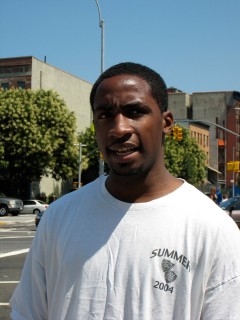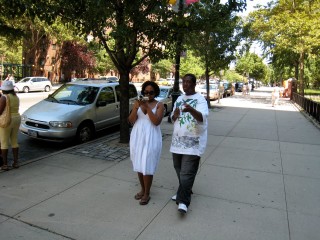Visualizing This Study: A Brief Video Overview of the Project
The two participants referred to in the video documentary, Phillip and Khaleeq (see Figures 1 & 2), wanted to know why gentrification was happening in Harlem. Along with their peers, Phillip and Khaleeq sought to discover specific activist efforts (e.g., mobilizing, organizing, writing letters) that served as responses to gentrification. Access to technology, as referenced in the documentary, helped us to digitally capture stories of change and to question the sociological distances (see Comber, Nixon, & Reid, 2007; Cushman, 1996) across communities (e.g., Harlem vs. Upper West Side, schools vs. community contexts) as we created literacy texts that tell intersecting stories about Harlem, given the community’s history in relation to current changes.
Known as a major site for black culture, life, and art in the United States, Harlem has been experiencing spatial changes for well over a decade (see also a history of Harlem from Columbia University). Before I moved to New York City in 2003, I sought to understand how the lives of youth and adults in communities labeled “dilapidated” and “gentrified” are affected by changing landscapes (see also the Black Harlem blog and Columbia University’s Manhattanville in West Harlem). In my work with high school students in Harlem, I noticed their growing desire to question, document, read, and write about everyday practices within local communities. The students I came to know were not disengaged from school learning, but rather highly affected by the realities (e.g., increasing rent, expensive housing constructions, the threat of sanctioned public spaces) affecting local, familial spaces. We discussed meanings of citizenship and public perceptions of urban communities in relation to the ways literacy strategies can be employed to promote activist agendas. Such conversations motivated us—youths and researcher alike—to write and exchange journals, a practice that helped to alleviate student fears of “not being good writer[s]” and that helped us incorporate literacy strategies in our work.
To discuss the literacy strategies employed by participants and how they used them in the process of videotaping each other to critique community change, I turn to Nadine Dolby’s (2003) insistence that “researchers begin with young peoples’ lives, and then reposition youth from passive receptors…to pedagogical actors who reshape the world through their everyday practices” (p. 268). Her sentiment is powerful as I consider how the daily practices of young people—who use video and who write in rhyme books (exchanged journals)—contribute to how they “reshape the world.” The youth I discuss here rely on acts of literacy to document community change. Thus, they are reshaping identities and the context in which they live by reflecting on local history, community artifacts, the presence of newness, and the activity systems that contribute to spatial change. Armed with video and digital cameras, these young people inquire into the meanings and purposes of gentrification in the community in ways that reposition themselves from receivers to actors of knowledge or agents of change (Dolby, 2003, p. 268). Their engagements with media instruments such as cameras and their burning desire to understand spatial change points to their critical literacy stances and stories.
Table 1 (below) provides selected participants’ reactions to gentrification, which frame the remainder of this webtext. They include reactions from Phillip, Khaleeq, Kim, Samantha, and a teacher at the high school, Mr. T.
Table 1: Selected Participants’ Reactions to Gentrification
| Phillip | Random reactions from interviews, surveys, & written responses: When rent goes up and displacement becomes a reality; when new people move in who “do not contribute to the community and seem afraid of residents” who’ve already been living there; when locally-owned stores are forced to close because expensive, corporate-run, chains are moving in; when signs appear “all over the community” advertising expensive high-rises with balconies “when before, the same people moving into them were afraid to take the train to Harlem.” Phillip’s reactions to gentrification, across year one to year three, included a sense of fear that his Harlem would become their Harlem and that his family and friends would no longer be able to afford to call it home. |
| Khaleeq | Random reactions from interviews & surveys: “Corporations taking over,” “new, tall buildings we can’t live in or buy,” and “new people moving in” are phrases Khaleeq frequently used to describe gentrification. He reacted to the changes by talking about history and making references to how local residents might have to take up new residences elsewhere: on the upper edges of Manhattan, in the Bronx, and, among other places, in southern states where the price of living seems much more affordable than in NYC. |
| Phillip & Khaleeq’s Collective Definition | From group sessions/shared writings: After much debate, they agreed that gentrification is a process of renewing—by renovating, reinvesting in, and rebuilding—low cost, deteriorating areas historically and/or currently occupied by poor & working-class residents of color. Through gentrification, property values and per capita income increases, additional businesses opening, & displacement of longtime residents would be likely. They reacted to this emerging definition by documenting (with video and digital cameras; through journal writing and interviews with residents) spatial changes occurring in Harlem. |
| Kim & Samantha | From a group interview session:They believe gentrification has positive and negative effects, with more of the latter surfacing for people who already live (“struggle”) in areas now being redeveloped. For them, gentrification creates tension, additional struggles, and raises the question: “Gentrification for who, for what, and at what price?” Their overall reaction—gentrification is not helping them deal with their daily realities and experiences—speaks directly to sentiments expressed by Phillip, Khaleeq, their teachers, and the community members who were interviewed for the larger study. |
| Mr. T | From a community video interview: Mr. T thinks gentrification should include the coming together of various groups of people across racial, ethnic, cultural, and linguistic identities. He does not see this happening in Harlem; instead, he believes Harlem is experiencing “ethnic succession” because one group (poor and working class people, mainly black) is gradually being pushed out by another (mainly white people moving to the area). He rejects this trend and believes there are other ways to improve the space and appeal of neighborhoods that can minimize the negative consequences that come about with change and displacement. |


